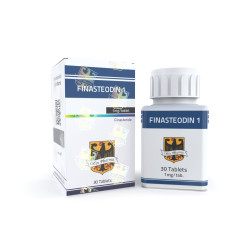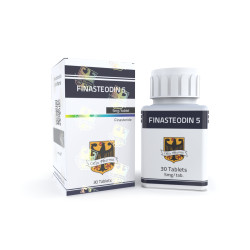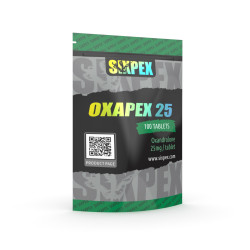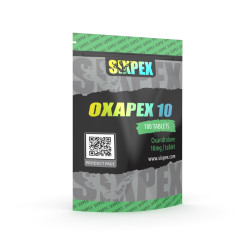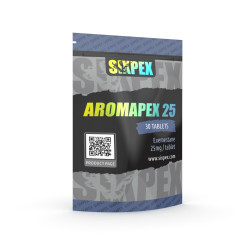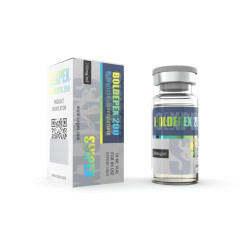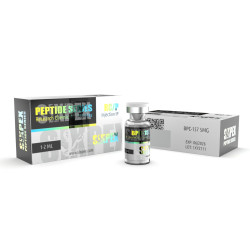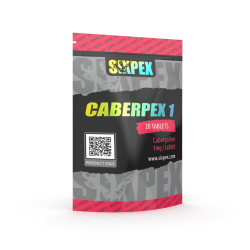Manufacturer: Sixpex
Substance: Finasteride
Pack: 30 Tablets - 1mg/tab.
Optimizing Finasteride Usage and Dosage for Bodybuilding Purposes
1. Introduction to Finasteride in Bodybuilding
Introduction In general, finasteride is a medication usually prescribed for treating male-pattern hair loss and benign prostatic hyperplasia, or enlargement of the prostate gland. Finasteride is known to completely inhibit the activity of the type 2 isozyme of 5α-reductase, which results in increased levels of DHT in serum and tissues expressing the 5α-reductase type 1 isozyme. Bodybuilders have recently piqued interest in the drug since there are potential benefits to using finasteride, such as preventing damage to the prostate and hair, helping to reduce skeletal muscle injury, and addressing sex hormone imbalance. Thus, it is crucial to fully realize the significance of this compound that is used within the bodybuilding community. If a drug is capable of improving muscle synthesis as a potential upside, it should ideally not have serious consequences for the endocrine system. Either way, a drug should not prohibit 75% of people from using it, even though it leads to lower DHT levels. Some bodybuilders argue that a higher ratio of testosterone to DHT might be beneficial for gaining muscle mass and strength, as DHT has a higher binding affinity for the androgen receptor than testosterone. Since the DHT concentration is reduced dramatically, the androgenic actions, i.e., dry joints, likely do not increase with finasteride. A misconception about finasteride is that it will actually enhance strength performance. Since the availability of free testosterone increases, one can assume that there is some rationale behind this idea. However, there is no confirmation of finasteride enhancing muscle anabolism directly, i.e., independent of strength due to hormonal modulation. Another necessary point to consider is the amount of time it takes for the synthesis of muscle tissue and strength to occur when bodybuilding with finasteride starts. If this method is very long, it is potentially impractical for most bodybuilders. Additionally, the source of high testosterone or even supplementation is important because of the enhanced supply of testosterone. This review will investigate finasteride administration times and dosages in order to optimize impact. The focus of this book will be on normal, long-term use as opposed to short-term supplementation of finasteride with one of the major anabolic androgenic steroids.
2. Mechanism of Action and Benefits for Bodybuilders
Finasteride is an inhibitor of the enzyme 5-alpha-reductase. It is this enzyme that converts testosterone into dihydrotestosterone, or DHT. DHT is a potent form of the male sex hormone, and the main use of Finasteride in the bodybuilding world is to mitigate hair loss by decreasing levels of DHT. On the plus side, bodybuilders are speculating that using Finasteride can positively affect muscle hypertrophy by either reducing overall serum DHT or by altering the hormonal environment. A reduced DHT level can maintain balance in the male hormonal system during a testosterone-boosting phase, such as aromatase inhibition or taking a testosterone booster. This balance ensures that not all exogenous or endogenous free testosterone gets converted into estrogens or other less anabolic hormones in the peripheral tissue.
Several studies have noted a reduction of circulating DHT levels to 60-80% of baseline levels at the highest administered Finasteride dose. Therefore, one could speculate that this reduction can lead to a faster recovery of muscle mass and strength because less muscle wasting occurs due to less DHT binding to the muscle and stimulating cell death. Based on this line of reasoning, anabolism would trump catabolism. However, using a sufficient dose of Finasteride alone would also reduce the overall DHT to androgen ratio, possibly leading to the negative effects commonly associated with low DHT. These can be increased fat mass and decreased muscle mass, overall performance, bone mineral density, libido, and erectile function. Of course, side effects vary individually and will also depend on dose and duration of usage. Scientists have seen both positive, negative, and inconclusive effects in various studies in various test groups. This also illustrates one of the most important aspects of using this or any other performance-enhancing supplement: everything depends on your individual response. A recent longitudinal population-based cohort study showed a variety of changes to circulating DHT status in response to age, body mass, and general health, and also a lack of correlation between various androgen levels and muscle mass. This reiterates the importance of individual trial and error and not being misled by overarching claims and indeed pop-scientific advice.
In conclusion, Finasteride can potentially decrease muscle catabolism and improve overall muscle-specific recovery by decreasing DHT-mediated apoptosis. However, this also comes with the risk of negative effects of low DHT and also shifting the testosterone to estrogen ratio in favor of unwanted effects in bodybuilders, as the estrogen-stimulating aromatase enzyme can profit from the spared testosterone due to less DHT having formed. Only through slow and careful experimentation will the individual bodybuilder find out whether and how to optimize the use of Finasteride for their needs. Keep in mind that higher dosages were not found to prevent hair loss more than 1 mg dosages in the various studies.
3. Optimal Dosage and Timing for Bodybuilding
Based on the results of this study, finasteride dosages up to 2 mg per day can be considered safe, though very low dosages (0.2-1 mg/day) will provide a more narrowly targeted effect with a lower risk of side effects. Besides dosage, other factors such as body weight, metabolism, training intensity, and the hormones and diet used can also influence the individual response to finasteride, promoting a 0.5 or 1 mg/day dose in lean bodybuilders, a 1 or 2 mg/day dosage in bodybuilders using high-carbohydrate diets, and a 2 or 5 mg/day dose in users of high-fat diets. However, currently, it is still impossible to advocate the use of finasteride. There are simply too many individual differences between the athletes. Before considering the use of finasteride, the participant should be sure to personally optimize his or her carbohydrate intake and to monitor the changes in the hormonal profile.
The half-life of finasteride in the body is 5 to 6 hours. Based on this information, it would be best for the bodybuilder to take finasteride daily, usually in the form of a tablet, around 30 minutes before a training session. Muscle building will be promoted for a few hours after administration, and conversion of androgen to estrogen does not actually take place in the other half of the day. Experiments have shown that muscle mass decreases when muscles are damaged while the one-off administration of a 5-alpha reductase inhibitor is delayed for 1 to 24 hours. Assuming that these results can be linked to the human model, bodybuilders who use a 5-alpha reductase inhibitor would respond better to a 5/2 training schedule for muscle groups during the day that they don't take the enzyme inhibitor.
4. Potential Side Effects and Mitigation Strategies
Finasteride has a number of potential side effects that users should consider prior to initiating usage. Sexual dysfunction, including reductions in libido and erectile quality, and the development of depressive and/or anxiety symptoms have been reported following finasteride usage, and are the most significant concerns facing an individual seeking to use the drug. Given that these effects can also result from anabolic-androgenic steroid use, pre-existing AAS-induced effects could be exacerbated through additional suppression of 5AR activity. Therefore, the use of finasteride to mitigate size loss following the use of 5α-reduced androgens is contraindicated. Inhibiting the activity of 5AR is also known to reduce the function of important steroid hormones, which can lead to negative psychological outcomes. These hormones are thought to have activity at gamma-aminobutyric acid type A receptors, and subsequent reductions in their biological activity are thought to have a negative impact on mood.
As bodybuilders using anabolic-androgenic steroids are potentially more likely to already be at heightened risk of experiencing impotence—likely the result of hypogonadism and/or testicular atrophy subsequent to AAS use—it should not be automatically assumed that side effects relating to sexual dysfunction do not occur. Instead, it is vital that individuals carefully monitor how their body responds to dosing and are aware that if these side effects do become apparent, discontinuation of the drug could be necessary to prevent long-term changes and restore sexual function. While the prevalence of the described side effects among bodybuilders is currently unknown, a number of clinical trials and case studies have reported on individuals experiencing the same or similar side effects at the appropriate doses. Concerns aside, many individuals adjust the dosage and flow of finasteride usage to slowly increase the amount of 5α-reduced androgens in the body, or use intracellular supplementation of pregnenolone.
5. Conclusion and Future Research Directions
In conclusion, while finasteride can indirectly have a positive effect on muscle growth via the reduction of endogenous DHT levels, a reduction in the rate of androgenic alopecia in younger bodybuilders may be preferential. Moreover, a very modest use of finasteride can be sufficient to maintain low DHT levels in hypogonadal individuals. Moreover, 0.2 mg EOD of finasteride may be sufficient for bodybuilders aiming to maintain their hair while undergoing anabolic steroid treatment – dosages higher than this do not appear to render any greater rapid detumescence effect or have a positive effect on net muscle growth. More micro-dosing studies involving more participants might be beneficial, and they may benefit from studies assessing 5 mg doses as well, since this dosage is more conventionally used or abused.
After several weeks of trial use, a discussion with a healthcare provider is needed to verify each individual’s response. With controlled research, knowledge of how much finasteride is required for others to reduce DHT levels in their bodies, effective doses for maintaining the desired amount of male pattern baldness, would be beneficial for both bodybuilders and the larger medical community. These studies should also take into account both short and long-term research and side effects; future research should investigate the use of this compound with various anabolic substances. These lower dosages might be considered for the prevention and eventual treatment of male pattern baldness only if the study results are verified in future research. One comment is of interest here – currently, there is research into the side effects and long-term effects of comprehensive approaches to slowing or stopping hair loss, although little is known about the results of dosages used to stop the hair loss.



